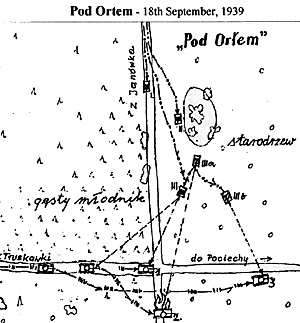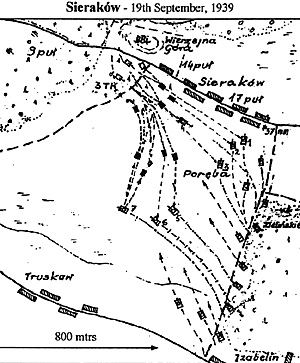1939 and "Brave Little Poland" pays the price for the years of vaccillation on behalf of the British and French premiers towards Herr Hitler`s brinkmanship. Sixty years on, Poland`s short, sharp, struggle against the German beast is unfortuantely still stereotyped by many C20th wargamers as being little more than Polish lancers charging Panzers. Time Gauntlet changed all that . . .
Now, it`s no secret that I like those little tin cans on tracks - tankettes - that abounded in the early stages of the Second World War. Most wargamers fed on a diet of armour penetration tables may shake their heads, but the truth is that these 'Davids' of the armour world often managed to pull-off astounding successes against their bigger and nominally superior 'Goliath' counterparts.
The mighty Panzers drove all before them, until that is 18th-19th September, 1939, when the Warsaw Operational Group of Cavalry under General Abraham, gave them a bloody nose. Not once, but twice.
The Panzers on the receiving end of this 'double-whammy' were from Major Thomasa`s 11th Panzer Regiment, which was equipped with the Czech built Pz.35(t).
My Polish is peesh poor but the following maps give enough details for replaying the engagements on the tabletop. For Pod Ortem, both sides enter the table at the same time. The Germans objective is to exit at least one armoured vehicle off the table edge opposite, whilst the Polish objective is to stop them.
When playing Sieraków, the Poles set-up first as they are defending. The Polish player can lay 3 platoons of riflemen or dismounted cavalry (for flavour), with perhaps one anti-tank rifle, one Medium MG with 3 belts of armour piercing rounds, and a Swedish 37mm Bofors anti-tank gun, in improvised positions in Sieraków or west of Hill 88. Hidden amongst the trees on the western edge of the table are six TK/S tankettes, at least four of which, preferably ALL, are armed with a 20mm cannon. These should be kept off table initially. The Polish Tankettes and gunners are Elite, whilst the infantry / cavalry are Regular or Elite if you find the game too much of a close run thing.
The German player should ideally begin the game believing that all he is up against are the infantry (tell him the Panzer Grenadiers are following behind and have models ready to add to the subterfuge). The Germans enter in road march formation at Izabelin. The Panzers are Elite to begin with but will automatically fall to Regular and take an immediate morale test when (and if) the first Panzer gets brewed, to simulate the shattering effect on their over-confidence.
The objective of the Germans to secure the village and clear the route off table. The Poles, aim to give the Germans a bloody nose and with luck and bravery, prevent the Germans from achieving their objective. Limit the number of game turns to prevent the German player/s from loitering around using their heavier firepower - they have to get stuck in ! - so say 8 - 10 turns depending upon rules.
Rules.
Rapid Fire ! Why Not ! No need to change scales unless you have retentive tendencies in which case call the Polish platoons - companies, and the German armour becomes a battalion. As the game is heavily based around the armour, use John Dowman`s additional armour rules which appeared in Wargames Illustrated ........... Squad Leader / ASL
| AFV | Gun Class | Armour Class | Speed |
|---|---|---|---|
| Czech Pz.35(t) | 5 | E | Medium |
| TK/S | 6 or MG | E | Fast |
So, who won ? Play it out on your own tabletop and you tell us . . . . . .
No Poles ? Well, change the scenarios to the Western Front in 1940 and turn the Polish armour into French or British - the French could be a mix of cannon and MG armed Renault FT17`s, whilst the British could be Vickers Mk VI`s or a couple of 2pdr armed Matilda MkII`s backed by some Matilda I`s with nothing heavier than a Vickers HMG. The encounters could also be easily transferred to the Russian front, with Soviet T-37`s or T26A`s and T26B`s coming to grips with Pz35(t)`s or PzIII Ausf C or D`s.
The sketch map shows the successive firing positions of TKS no.III from where it immobilised German Pz.35(t) no.1, brewed no. 2 and immobilised no.3.
This makes an excellent little solo game, where the heavier German armour is caught in the flank by the Polish tankettes as the Panzers emerge from the wood. The key to this scenario for individual tank combat is probably the visibility rules, make sure that the Poles are given the edge through being able to anticipate the appearance of the Germans, whilst the Germans must locate the Poles once they are clear of the wood and any wrecks. Make the scenario harder by giving the Poles just one TKS and two mg armed TK tankettes; or easier by turning the German Pz.35(t)`s into a mix of PzI and II`s or even a motorcycle and armoured car recce unit.


Back to The Gauntlet No. 17 Table of Contents
Back to The Gauntlet List of Issues
Back to Master Magazine List
© Copyright 1999 by Craig Martelle Publications
This article appears in MagWeb (Magazine Web) on the Internet World Wide Web.
Other military history articles and gaming articles are available at http://www.magweb.com